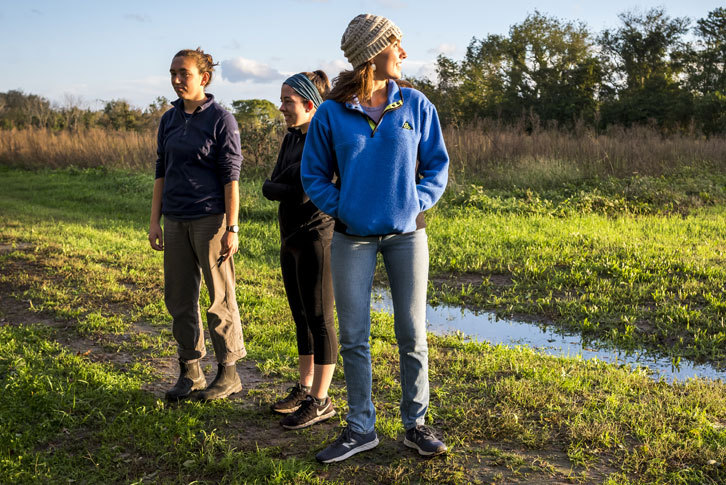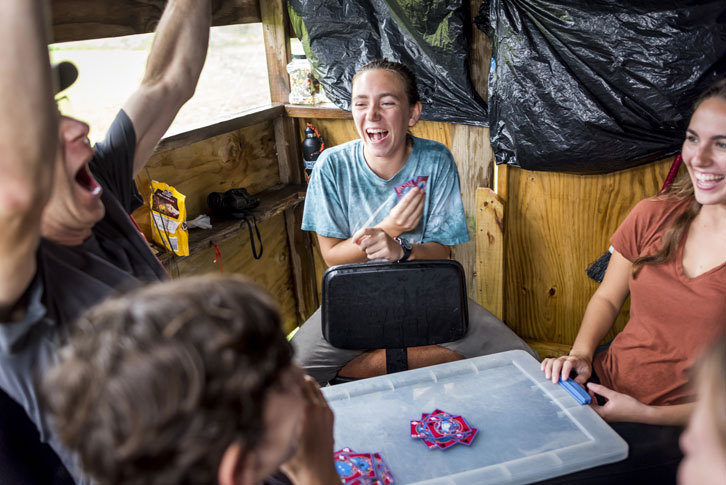There comes a time when it’s time to go. And so, following their instincts, 50,000 raptors (birds of prey that include eagles, falcons, hawks, ospreys and harriers), having summered in Canada and New England, follow a flight path down the East Coast. They ride the autumn northwesterly winds down to the peninsula of Cape May, N.J., hop the daunting Delaware Bay and fly as far south as Argentina.
The dangerous journey is fraught with obstacles ranging from bad weather and predators to tall buildings and other man-made objects, exhaustion and starvation. If there’s any kindness in migration, it might be in the unlikely act of being delayed in a field on Cape May by some Colby-Sawyer students and their professor for research and admiration.
The Project
More than two decades ago, a friend invited Professor Nick Baer to help with the Cape May Raptor Banding Project. While birds were banded, Professor Baer was hooked. He’s been volunteering with the project ever since on its mission to conduct long-term monitoring of migrating raptors’ status and trends.
Over the years he has shared that enthusiasm with more than a dozen students. This fall, environmental science majors Taylor Devaney ’20, Anna Hubbard ’20 and Taylor Spadafora ’20, joined Professor Baer and his son, Eli, on the cape, for banding and data collection on flat flies and avian pathogens. Flat flies spend their whole life cycle on a bird and feed on its blood; to test the fly for West Nile and Eastern Equine Encephalitis (EEE) is a noninvasive way to test the birds.

Where the Magic Happens
Thursday dawned gray, humid in the mid-70s, with unfavorable winds from the south-southeast, but nothing could dampen Professor Baer’s enthusiasm. “Every day, there’s a lot of potential,” he said, looking to the sky. “There’s a few birds around, so that’s good. We just have to catch one.”
By 8:45 a.m., he’d introduced the students to the mist nets and showed them how to set up the traps. Two Cooper’s hawks and an eagle floated in the distance.
After a lesson on the data sheets and a tour of the plywood blind, the crew settled in to wait. A downpour moved through, followed by a peregrine, and two each of eagles, ospreys and kestrels.
“Free bracelets!” Eli offered. “Get your bird bling here!” The birds stayed high and away from the station with its array of bands engraved with numbers that can be tracked when a bird is captured and provides data on how long a bird lives and how far it migrates. Card games, lunch, homework and conversation broke up the waiting game.

Then, amid talk of packing it in, a male sharpshinned hawk, the smallest of the forest hawks but the ultimate songbird killer, flew into the mist nets. Whooping, Professor Baer grabbed a small gray can to transport the bird into the blind. With his students gathered around, he taught them what the body feathers revealed about age: It was a hatching year bird, on its first journey but already banded with a “Cape May handcuff.” He recorded its weight of 100 grams, measured its tarsal and wing chord, and checked for flat flies. AT&T, as Professor Baer called his student trio, were giddy as they held and then released their first raptor.
“He’s so passionate about what he teaches,” Hubbard said of her professor. “He makes us feel like teammates who are working with him on research. It’s important to learn through experiences like this. We really do think outside the classroom at Colby-Sawyer.”
Friday held the promise of cool sunshine and favorable winds. Seated in the blind by 8 a.m., Hubbard took the luring seat. Two minutes later, the first of the day’s 38 raptors touched down under a bow trap and Hubbard pulled the trigger. The male Cooper’s hawk carried four flat flies and had no crop — a hungry raptor.
“It’s designed to hunt birds; look at its gyroscopic head,” Professor Baer said, before whispering to the hawk, “You’re incredible.”

“This whole experience taught me I have more patience than I thought I did,” Hubbard said later. “It took a lot of courage to pull the trigger line to have the trap snap shut and to handle the birds for processing. The amount of information on birds of prey that was thrown at us was immense, and to think there is this amount of information for every other animal on the planet is overwhelming, but it made me realize I could pursue many niches for my career in field work or animal rehabilitation.”
Spadafora took the luring seat after the fourth bird and immediately landed a fifth, another hatching year male Cooper. “This is never going to get old!” she said. Ten minutes later, a 1,300 gram Red-tailed hawk had everyone’s attention followed by a Merlin that was very vocal about the twist on its day.
“We’re lucky to catch a Merlin, as they move so fast and usually pass through the station before you have time to react,” Professor Baer said. “Look at the strong beak designed to break its prey’s spine. This is a good day.”
If Merlins are the speed demons of the sky, their cousin the American Kestrel has the prettiest feather patterns, he contends, while the Northern Harrier, also known as the gray ghost, is one of the coolest to see as it teeters in the wind low over fields while hunting.

By late afternoon, the raptors were coming in from all angles and everyone was comfortable in their roles; at day’s end, they’d gathered data on two Merlins, two Red-tailed hawks, a kestrel and a Northern Harrier, six Sharp-shinned Hawks and 26 Cooper’s hawks.
More than that, the trio affirmed they were on the right flightpaths for their own futures as they bonded even more with the professor who’d invited them to New Jersey and housed, fed and taught them about much more than just raptors.
“Nick is not only our professor but our mentor, and it’s important to take advantage of all the opportunities offered in college,” Devaney said. “I’ve never heard of friends at other colleges who have been invited to travel with their professors, or who would want to spend 10-hour days in a little box watching birds with their teachers.”
Hoisting the last Cooper’s hawk of the day into the air for release, Professor Baer offered his benediction: “Buddy, I wish you the best of luck. You’re gonna do just fine.” His farewell sounded a lot like what he’s told his students for the past 15 years as they’ve set off into the world.
Visit colby-sawyer.edu/environmental-science to learn more about the environmental science major at Colby-Sawyer College.